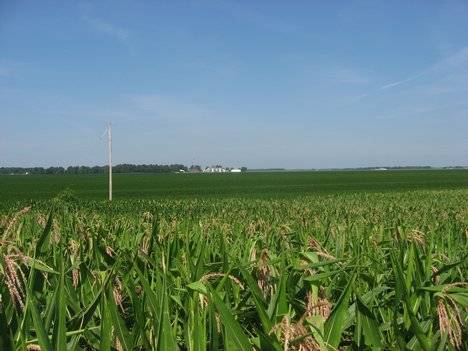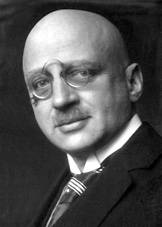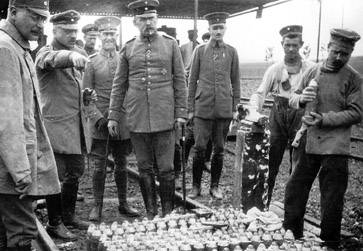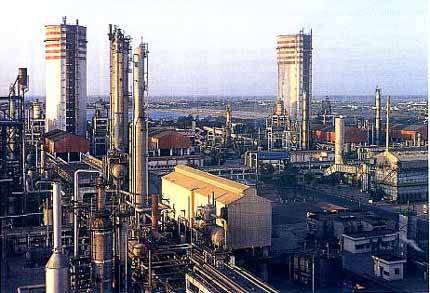 As the harvest season goes into full swing on the factory floor hereabouts, and the golden rivers of corn kernels begin their journey toward high-fructose corn syrup, motor fuel and McDonald’s hamburgers, I turn to thoughts of gas — natural gas, that is, methane, CH4.
As the harvest season goes into full swing on the factory floor hereabouts, and the golden rivers of corn kernels begin their journey toward high-fructose corn syrup, motor fuel and McDonald’s hamburgers, I turn to thoughts of gas — natural gas, that is, methane, CH4.
In truth, the harvest was not entirely what brought gas to mind, although corn would not be flowing in its usual torrent were it not for gas, which is the essential feedstock for nitrogen fertilizers such as anhydrous ammonia, which are essential for growing lots of nitrogen-hog plants like corn. It was the foofaraw around Obama’s Nobel Prize controversy that sparked a memory of the controversy over a previous Nobel, the 1918 prize in chemistry to the German Fritz Haber, who in 1909 discovered how to make lots of ammonia from atmospheric nitrogen.
 Haber’s story deserves retelling in its own right, but it also touches on issues of science and society, resource use, international politics and war (in places like Afghanistan) and the contingencies and ironies of history, and how all these shape our lives on these prairies surrounding a university most famous for its scientific research.
Haber’s story deserves retelling in its own right, but it also touches on issues of science and society, resource use, international politics and war (in places like Afghanistan) and the contingencies and ironies of history, and how all these shape our lives on these prairies surrounding a university most famous for its scientific research.
The controversy over Haber’s Nobel was not about his 1909 discovery, although it did allow Germany to manufacture explosives (you need nitro) when the British blockade denied German access to nitrate mines. Germany would not have been able to prosecute the First World War without Haber’s invention. Haber was undoubtedly proud of this, for he was a great German patriot who had been made a captain by the Kaiser and decorated for his scientific service to the war.
At dawn, on April 22, 1915, Haber was near Ypres, Belgium, personally overseeing the opening of some 5,700 canisters of a chlorine gas he had developed at the behest of the War Office. It created a low-hanging, greenish-yellow cloud that slowly drifted over miles of Allied lines. The number of direct and indirect deaths from this first effective use of chemical weapons is unclear, but 35,000 is a reasonable guess.
 Haber (at left, pointing) denied that gas warfare was somehow inhumane, because in war death is death and it doesn’t really matter how it happens. His wife, also a chemist, disagreed, calling it an immoral perversion of science. After a violent argument less than a month after the Ypres attack, she took his service revolver and shot herself in their garden. She died the next morning and Haber immediately left for the eastern front to oversee a chemical attack on the Russians.
Haber (at left, pointing) denied that gas warfare was somehow inhumane, because in war death is death and it doesn’t really matter how it happens. His wife, also a chemist, disagreed, calling it an immoral perversion of science. After a violent argument less than a month after the Ypres attack, she took his service revolver and shot herself in their garden. She died the next morning and Haber immediately left for the eastern front to oversee a chemical attack on the Russians.
Not surprisingly, given his active and enthusiastic role in developing chemical warfare, scientists from the U.S., France and Britain were adamantly opposed to Haber getting the Nobel Prize, considering him a war criminal. (This is not to say many scientists from the allied countries were not doing the same sort of thing; they were.)
Nonetheless, Haber was eventually awarded the prize, and probably justifiably so, given the enormous effect his discovery of how to make large amounts of ammonia has had on the world. More about that anon, but first a couple of other things about Haber:
Haber had previously studied the effects of poison gas and had developed what is still known as Haber’s rule: a long exposure to a low concentration of a poisonous gas is (not always, but often) as deadly as a high concentration for a short time. It’s a parameter used now in such things as pesticide development. In the 1920s, scientists working under his direction developed a cyanide gas insecticide they named Zyklon B.
When Hitler came to power, all of Haber’s patriotic work on behalf of Germany accounted for nothing because he was born a Jew. He had to flee Germany, and he died of a heart attack shortly thereafter. In a bitter irony, the Nazis deployed Zyklon B at Auschwitz and other death camp gas chambers, where many of Haber’s relatives died.
 Today, about 100 million tons of nitrogen fertilizer are produced per year, nearly all via the process Haber invented. The process consumes up to five percent of the world’s annual gas production and that fertilizer sustains one-third of the Earth’s population. Without it, yields would plummet and catastrophic famines would ensue.
Today, about 100 million tons of nitrogen fertilizer are produced per year, nearly all via the process Haber invented. The process consumes up to five percent of the world’s annual gas production and that fertilizer sustains one-third of the Earth’s population. Without it, yields would plummet and catastrophic famines would ensue.
On the other hand, it might be argued that Haber’s process has only forestalled a reckoning of population v. resources, and has led to other problems, such as an overreliance on monoculture (you can’t deplete the soil of essential nutrients if you have industrial sources to replace those nutrients a plant like corn sucks up), which invites pests to evolve to develop resistance to pesticides, inviting the need for new pesticides, ad infinitum. As an aside, we might note why early in the invasion of Iraq, we kept finding chemical WMD facilities that turned out to be pesticide plants.
Beyond that, nitrogen from farming has become a serious water pollution problem. These and other problems, as well as the results and consequences, intended and not, of the application of the scientific work that helps construct our local space and lives, are the subject of part 3. But before that we’ll return to the issue of gas in part 2.








